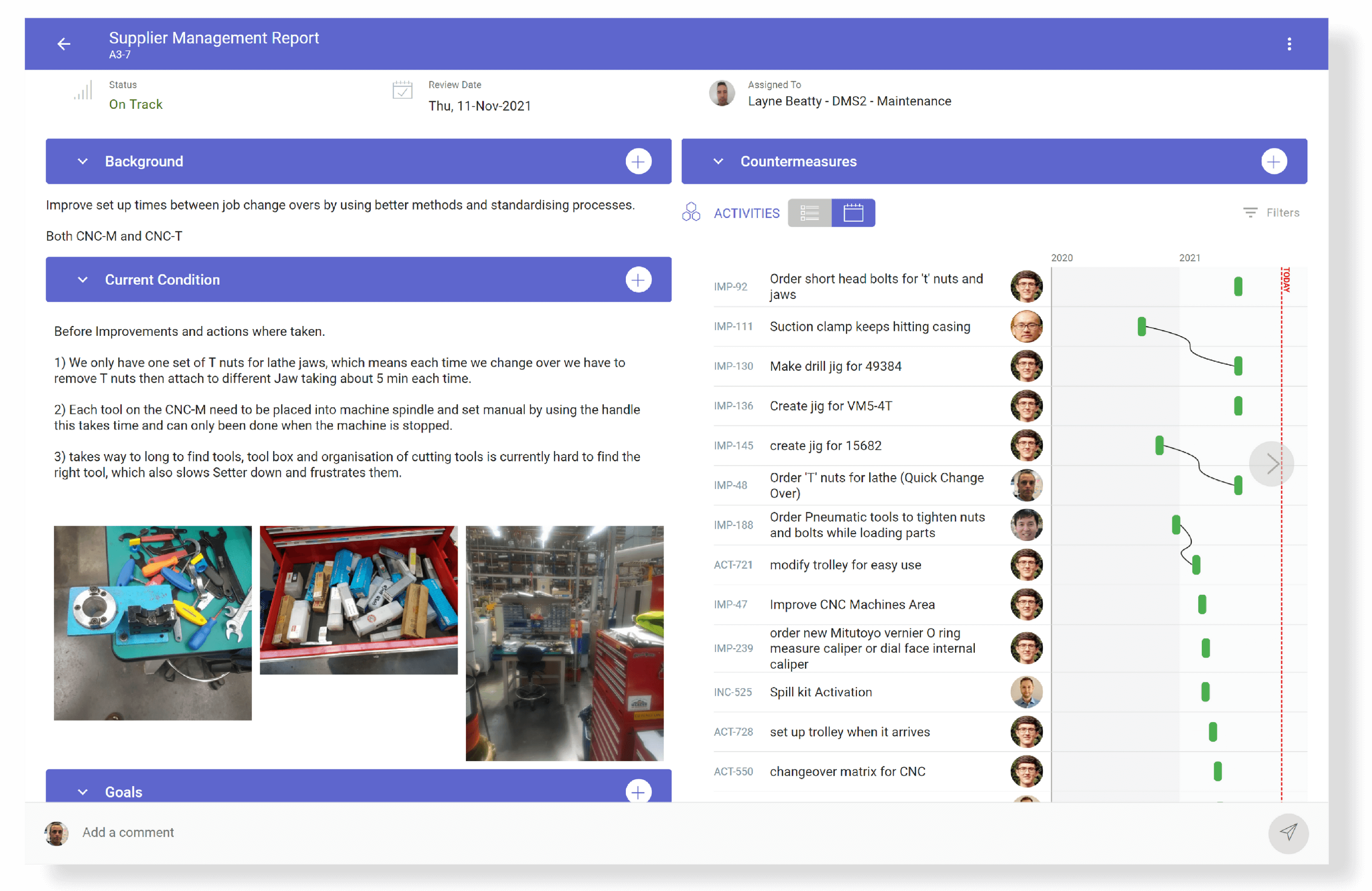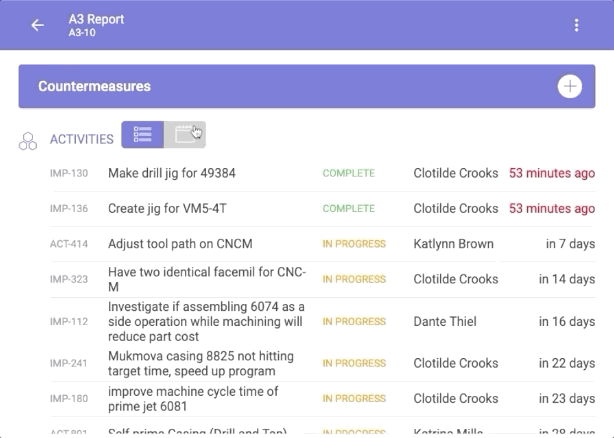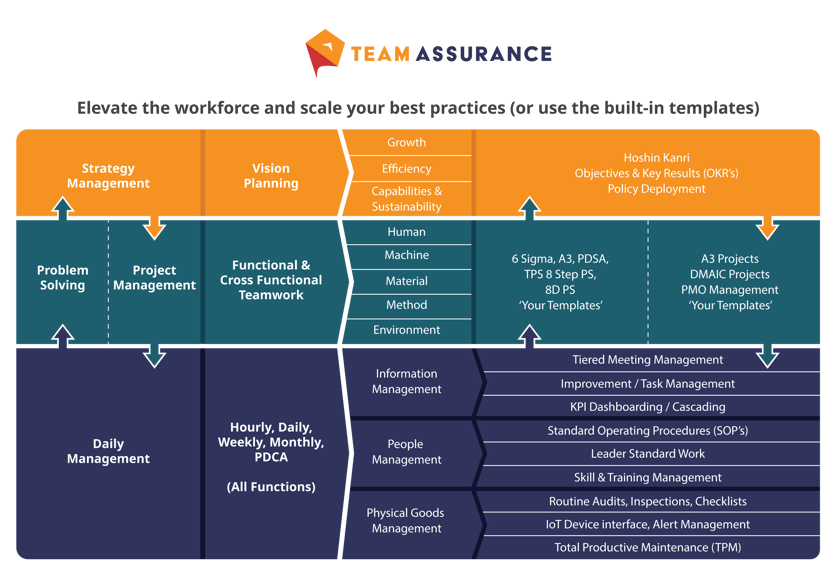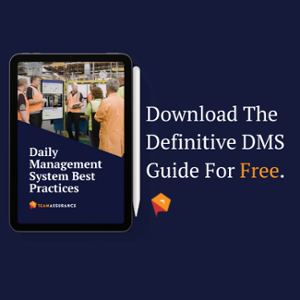The Power of A3 Thinking

Approach improvement utilising A3 methodology to support your improvement cycles. We discuss the power of A3 thinking and how to set yourself (and your teams) up for problem solving success.
There are a few layers and approaches when it comes to improvement, but the one constant is the thinking, methodology and practice that underpins it: PDCA (Plan Do Check Adjust). PDCA is the engine that propels us forward creating a structure and an approach to any obstacle or objective. PDCA helps us individually and collectively to learn, solve problems and get better through incremental and iterative cycles of improvement.
The Aspects of A3 Thinking
With Daily Visual Management we are practicing PDCA through exposing the waste, frustration and opportunity in our process through the lens of our visual process metrics and standards. This allows us to see the consistency of, and conformance to, aspects of the established processes. It also highlights the inconsistency and deviation in others.
The activity at this level is generally more granular and conducted over short time frames. The nature of the issues that are exposed require a reactive / corrective approach. These issues are managed and visualised through a manual or digital documentation process in the huddle. These are generally aimed to be closed out in a handful of working days.
Our daily visual management typically has an hourly/daily focus. There is longer term visibility in the form of tracking process performance over a weekly and/or monthly timescale. From a longer term, higher level view we will begin to see patterns and trends emerge from the data. These will serve to validate the efficacy of the daily metric, as well as expose bigger picture and chronic process issues.
At the value stream and strategic level we need to address process issues within our current state and set proactive longer-term objectives. Otherwise we're not going to move our process and business forward. These will be exposed through value stream mapping and the Hoshin Kanri process. These previously discussed lean tools provide clarity and visibility on our improvement opportunities, as well as our our organisational goals.
The A3 Problem Solving Method
This is where A3 thinking comes into play and where it has emerged as a method to yoke the two fundamental work management processes of Hoshin Kanri and problem solving. It is neither a solely “top down” or a “bottom up” approach to learning and process improvement. A3 problem solving combines (and embodies) both whilst serving as a powerful learning tool. It not only teaches and challenges the A3 owner but allows the individual to learn and coached through the process.
At its core, A3 refers to a literal sheet of 11” by 17” inch paper. However, from a Lean perspective the term takes on significantly more importance - referring to a routine way of thinking and solving problems.
It is (traditionally) a standardised one-page report format rather than a multi-page document. It is generally structured in a way where the left hand side is dedicated to the current state for analysis and the right hand side holds the future state and implementation plan. It is also a very human-centric structure in terms of the way it is organised; think of left brain / right brain theory. Here the left brain is more orderly, analytical , and verbal whilst the right brain is more visual, intuitive and creative.
Good quality problem solving requires both.
A3 Template Structure
An A3 problem solving document generally includes to following elements:
- Title: Clarifies the problem statement, initiative or issue
- Owner: Identifies who owns the A3
- Current condition: Summary of what is known and how the process is currently performing. Specific data and evidence that establishes the business context to support and justify the improvement activity
- Target Condition: Identifies the desired outcome. Specifically - what do we want to achieve? What? By how much? By when? Describes what the process should look like at the end of the activity. What are the quantitative and qualitative measures?
- Obstacles: Analysis of the situation and the underlying causes that have created the gap or are known/likely impediments between the current state and the target condition
- Proposed countermeasures: What needs to be done to contain the issue/problem in the short term if required. What are the corrective actions to address the problem, reduce the gap or achieve the goal?
- Action Plan: What are the steps in order of priority, who will do what, by when? to reach the outcome or short-term target condition
- Follow up: Review/Reflection/Learning process. How to we check and validate the actions have been effective in achieving the goal? How do we capture and share the learning?
The elements of the A3 follow each other in a logical sequence. They should paint the picture and link of all facets of the problem in a clear, concise way. The template itself, therefore, is secondary in many respects to getting the message through with clarity.
That's why the flexibility of digital platforms, and mobile technologies, lend themselves to A3 problem solving. Tools like TeamAssurance allow you to turn traditionally static A3 documents into living documents that record activities (planned and completed) throughout the entire PDCA cycle.
For example, being able to list tasks in a team’s daily action list, record progress and provide real-time notifications to the team:
Or being able to visualise (and drill down into) a timeline of activities:
Clarity is Key in A3 Thinking
Remember, what is most important, is the underlying thinking that guides the owner through the cycles of PDCA to work toward learning and improvement outcomes. The routine and discipline of following the form through a scientific method over time creates habitual behaviours. This nurtures an organisational mindset within the problem solvers and facilitates continual learning.
The A3 should be a ‘go to’ tool with a specific set of stimulus criteria. The A3 can easily incorporate other tools and methodologies such as Ishikawa diagrams, 5 Whys and Improvement Kata to compliment (and enhance) the process. The key always comes down to visualising the thought process of the owner, taking action, and understanding the effectiveness of the activity through reflection, learning and knowledge sharing.
A3 Projects Are a Part of the Greater C.I. Framework
The A3 is a powerful, and central tool, in an ideal daily management process. It will support the alignment of people with their organisational and department goals each day, every day. Plus, it focuses efforts and conversations on the issue at hand. However, utilising A3 project should by no means be a 'set and forget' process nor should these be developed in isolation. Standardised problem solving techniques, Standard Operating Procedures (SOPs), and a Tiered Daily Management process supporting the entire PDCA loop are also key to success when it comes to completing A3 tasks.
The illustration below demonstrates how we designed TeamAssurance as an interconnected platform to avoid disconnected ‘Point Solutions’ (digital or analog) that can lead to sub-optimal performance of your continuous improvement efforts.

If you’re a business in need (or a consultant with clients in need) and you'd like to discuss the opportunities that digital-aids to Lean tools provide contact us for a demonstration of the TeamAssurance platform.


